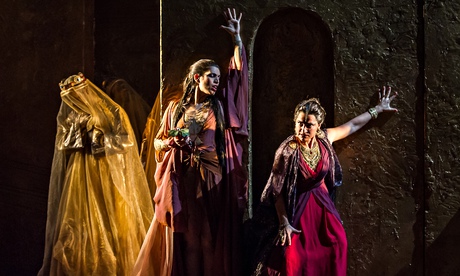
In the early days, people lent chairs from their own homes, carrying them through the narrow streets to the ramshackle theatre to ensure the orchestra could sit down. Wexford Festival Opera has always relied on the generous participation of the local community. Today the volunteers are still there – 347 of them this year – but the festival is an international event, housed in a state-of-the-art theatre, opened in 2008, with a near perfect acoustic and a collection of international design awards. Last week, on the opening night of the annual 12-day Wexford festival, the building was officially named Ireland’s national opera house.
This means Ireland is no longer the one country in the EU without a state opera house. Visitors flock from all over the world for this autumn festival, which coincides with the dying embers of the summer season. Salzburg over? Time to head to a former fishing port on the south-eastern corner of Ireland for opera rarities performed to the highest standards.
When a local GP, Dr Tom Walsh, founded the festival in 1951 with his friend the postman and the help of some canny shopkeepers, postwar Wexford was geographically isolated and economically depressed. Walsh can have had no idea that by 2014, its 63rd year, his tiny festival would be selling nearly 21,500 tickets and contributing ¤8.5m to the region’s economy. This year’s repertoire included the comic Don Bucefalo by Cagnoni and Silent Night (2011), a Pulitzer prize-winning work by Kevin Puts, receiving its European premiere. The opera which attracted most interest, however, was the “other” Salomé, not by Richard Strauss but by the forgotten Antoine Mariotte (1875-1944).
This French naval officer, whose small oeuvre has sunk without trace, abandoned the high seas and turned to composition and conducting. He was a pupil of the arch-conservative Vincent d’Indy. Another five operas aside, Mariotte’s main musical distinction seems to have been to write a piano sonata (1906) in the oddly underused key of F sharp minor – putting him in the same company as Koussevitzky and his double bass concerto, a red herring perhaps but we are in aquatic mood. Clearly, as a composer, Mariotte was small fry.
Strauss should not have wasted his energies, and money on expensive copyright lawyers, repressing Mariotte’s Salomé. (Having begun his opera in the 1890s before Strauss, Mariotte made the fatal mistake of finishing it after.) A 1908 premiere and a short initial limited run aside, it has scarcely been seen since. Montpellier Opera staged it in 2005, back to back with Strauss’s version and using the same designs. The bleak modernist staging – I remember, chiefly, a large black funnel and men scurrying around in short trousers – missed the radical aesthetic distinction between the two works.
This is where the interest lies. Whereas Strauss’s masterpiece is expressionist, ear-piercing and Germanic, Mariotte’s is soft-edged and rooted in the French symbolist mood of Debussy. Strauss bursts into the 20th century but Mariotte remains steeped in the woozy decadence of fin-de-siècle Paris. In that sense he is closer to the language and atmosphere of Wilde’s original play, written in French and only the latest of dozens of plays, novels and poems about the dancing girl who seemed to sum up a profane, if wholly inaccurate, notion of the Orient for western artists.
Mariotte’s orchestra is half the size of Strauss’s, heavily dependent on double harps, triple woodwind and large brass section. His skill at orchestral colour was evidently greater than his sense of rhythmic adventure. In practice this means vivid, often inventive instrumental writing in flowing, horizontal lines with almost no conflict. The ear cries out for some brutish interruption. David Angus, conducting the highly capable Wexford Festival Orchestra, spent much time beating in two or four, and if there were syncopations they were subtle beyond notice.
Wexford’s cast was confident and accomplished. Both Salomé (Na’ama Goldman) and her mother Hérodias (Nora Sourouzian), whose notions of maternal love take some swallowing, are mezzos. (“Well spoken,” Hérodias interjects, when her daughter demands the Baptist’s head on a plate). Hérode, the admirable Scott Wilde, is a bass, less threatening than the insidious, snivelling tenor of Strauss’s score. Emma Watkinson, as Hérodias’s beleaguered page, offered a brilliant line in neurotic anxiety. The Russian baritone Igor Golovatenko managed to make a mighty impact despite the tedium of the vocal writing for this sanctimonious quasi-messiah Iokanaan/Baptist.
In the title role, Goldman, whose rapid vibrato gave a distinctive, interesting timbre to this young Israeli’s sound, made what she could of the ponderous drama. The music for her dance of the seven veils had too rustic a feel, all rather amiable and earthbound for a flighty sex murderess. She tossed her veils around, not quite à la Loie Fuller voluptuous but still effective, until down to a body suit.
The director Rosetta Cucchi and designers Tiziano Santi (sets) and Claudia Pernigotti (costumes) had turned, with detailed eye, to the paintings of Gustave Moreau. He was feverish in his fascination with the subject. Even the androgynous flat-chestedness of Salomé came straight from Moreau’s hundreds of images – bejewelled, tattooed, and hard to distinguish from his equally sexless Orpheus and St Sebastian. The divided stage, with Iokanaan’s cistern prison at the back and stairs downstage from which he emerged, made clear sense of the narrative. It looked stunning. A chorus of slave-priests glided around in golden organza, like inverted ice-cream cones wearing coronets – a weird wonder to behold.

